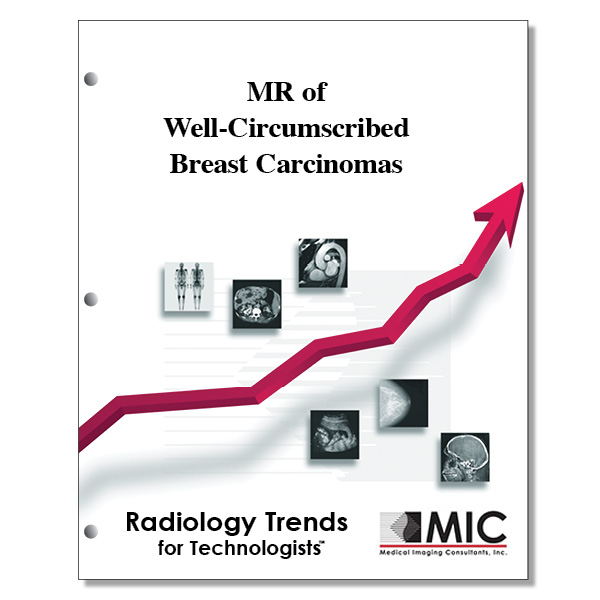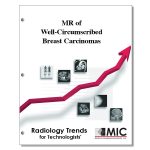

MR of Well-Circumscribed Breast Carcinomas
MR breast imaging technique is reviewed including contrast agent administration and uptake assessment in the evaluation of breast carcinoma.
Course ID: Q00325 Category: Radiology Trends for Technologists Modalities: Mammography, MRI, Nuclear Medicine
2.0 |
Satisfaction Guarantee |
$24.00
- Targeted CE
- Outline
- Objectives
Targeted CE per ARRT’s Discipline, Category, and Subcategory classification:
[Note: Discipline-specific Targeted CE credits may be less than the total Category A credits approved for this course.]
Breast Sonography: 1.50
Patient Care: 1.00
Patient Interactions and Management: 1.00
Procedures: 0.50
Pathology: 0.50
Mammography: 1.50
Procedures: 1.50
Anatomy, Physiology, and Pathology: 0.50
Mammographic Positioning, Special Needs, and Imaging Procedures: 1.00
Magnetic Resonance Imaging: 2.00
Patient Care: 0.25
Patient Interactions and Management: 0.25
Procedures: 1.75
Body: 1.75
Nuclear Medicine Technology: 1.00
Patient Care: 0.50
Patient Interactions and Management: 0.50
Procedures: 0.50
Endocrine and Oncology Procedures: 0.50
Registered Radiologist Assistant: 1.75
Procedures: 1.75
Thoracic Section: 1.75
Sonography: 1.50
Patient Care: 0.50
Patient Interactions and Management: 0.50
Procedures: 1.00
Superficial Structures and Other Sonographic Procedures: 1.00
Radiation Therapy: 1.50
Patient Care: 0.75
Patient and Medical Record Management: 0.75
Procedures: 0.75
Treatment Sites and Tumors: 0.75
Outline
- Introduction
- Intracystic Papillary Carcinoma
- Invasive Papillary Carcinoma
- Mucinous Carcinoma
- Medullary Carcinoma
- Metaplastic Carcinoma
- Malignant Phyllodes Tumor
- Conclusions
Objectives
Upon completion of this course, students will:
- identify the conventional breast imaging modalities
- understand how MRI enables differentiation between benign and malignant lesions
- learn about kinetic assessment
- identify type II kinetic curves
- recognize characteristics of lesion margins associated with malignancy
- learn the role of MRI in breast lesion assessment
- know requirements of DCE
- realize the importance of breast MR quality control measures
- describe characteristics of intracystic papillary carcinoma
- recognize the composition of intracystic papillary carcinoma
- know the core sequences currently used in breast MR imaging
- identify the type of kinetic curve from intracystic papillary carcinoma
- know the prevalence of bloody nipple discharge associated with invasive papillary carcinoma
- identify MR appearance of intracystic papillary carcinoma
- describe the appearance of invasive papillary carcinoma
- know the structure of the fibrous wall surrounding invasive papillary carcinoma
- recognize histological properties of mucinous carcinoma
- understand characteristics of mucinous carcinoma that can be unfavorable
- recognize the type of mucinous carcinoma with a more favorable outcome
- know how age affects outcomes of mucinous carconoma
- realize that a type I persistent curve doesn’t mean there’s no concern of malignancy
- know the MR appearance of mucinous carcinoma
- understand the prevalence of medullary carcinoma, both overall and in the younger population
- identify image manifestations of medullary carcinoma
- identify a common artifact seen on MR breast images
- reinforce understanding of curve contour on kinetic data sets
- learn the purpose of computer aided detection (CAD) software
- know CAD applies different colors based on delayed phases of the kinetic curve
- recognize the purpose of subtraction methods incorporated with DCE MRI
- understand the meaning of metaplasia
- learn characteristics of metaplastic carcinoma
- identify properties that affect the metaplastic carcinoma complexities seen on US
- identify properties that affect how metaplastic carcinoma appears on MRI
- know how phyllodes tumors are histotypically divided
- identify additional properties used for phyllodes assessment
- learn why phyllodes requires excision
- recognize that malignant phyllodes tumors mimic a benign lesion
- understand enhancement properties from certain sensitive areas of the phyllodes tumor
- know what lesion does not demonstrate contrast enhancement on MRI
- understand how MRI helps to characterize well-circumscribed, benign-looking breast lesions
